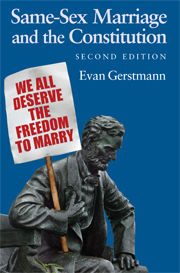Book contents
- Frontmatter
- Contents
- Acknowledgments
- Preface to the Second Edition
- PART I THE CHALLENGE OF SAME-SEX MARRIAGE
- PART II MARRIAGE AS A FUNDAMENTAL CONSTITUTIONAL RIGHT
- PART III RIGHTS AND EQUALITY
- 6 Should Courts Create New Rights?
- 7 Identifying Fundamental Rights
- PART IV RIGHTS IN A DEMOCRATIC SOCIETY
- Bibliography
- Index
7 - Identifying Fundamental Rights
Published online by Cambridge University Press: 05 September 2012
- Frontmatter
- Contents
- Acknowledgments
- Preface to the Second Edition
- PART I THE CHALLENGE OF SAME-SEX MARRIAGE
- PART II MARRIAGE AS A FUNDAMENTAL CONSTITUTIONAL RIGHT
- PART III RIGHTS AND EQUALITY
- 6 Should Courts Create New Rights?
- 7 Identifying Fundamental Rights
- PART IV RIGHTS IN A DEMOCRATIC SOCIETY
- Bibliography
- Index
Summary
In the previous chapter, we saw that the promise of legal equality cannot be fulfilled without some substantive content. This chapter attempts to set forth a plausible account of what that content might be and whether it should include the fundamental right to marriage. Four factors are set out for identifying nontextual fundamental rights, none of which are novel. All four are criteria familiar to many judges, lawyers, and legal scholars, and all four have been used by the U.S. Supreme Court from time to time in various contexts. The problem has been that the Court has used these criteria too sporadically and often implicitly rather than explicitly. As a result, as the Court has lurched from clause to clause in its fundamental rights jurisprudence, it has not systematically set out its criteria for identifying fundamental rights. What follows is not grand theory, but merely an explicit identification of criteria the Court has used that helps lay the foundation for reasoned discussion about which nontextual rights should be considered fundamental. It will be shown not only that each of these factors supports the Court's holdings that marriage is a fundamental right, but also that the right to marry should be construed as sufficiently broad to include same-sex marriage. In identifying these four criteria, I assume that most people agree upon the following goals:
Leave most policy decisions to the democratic process.
Expect judges to refrain from simply reading their own values and policy preferences into the equal protection clause.
Hold judges accountable by setting out comprehensible standards for what is a fundamental right – standards that would guide (not eliminate) judicial discretion.
[…]
- Type
- Chapter
- Information
- Same-Sex Marriage and the Constitution , pp. 138 - 160Publisher: Cambridge University PressPrint publication year: 2008



